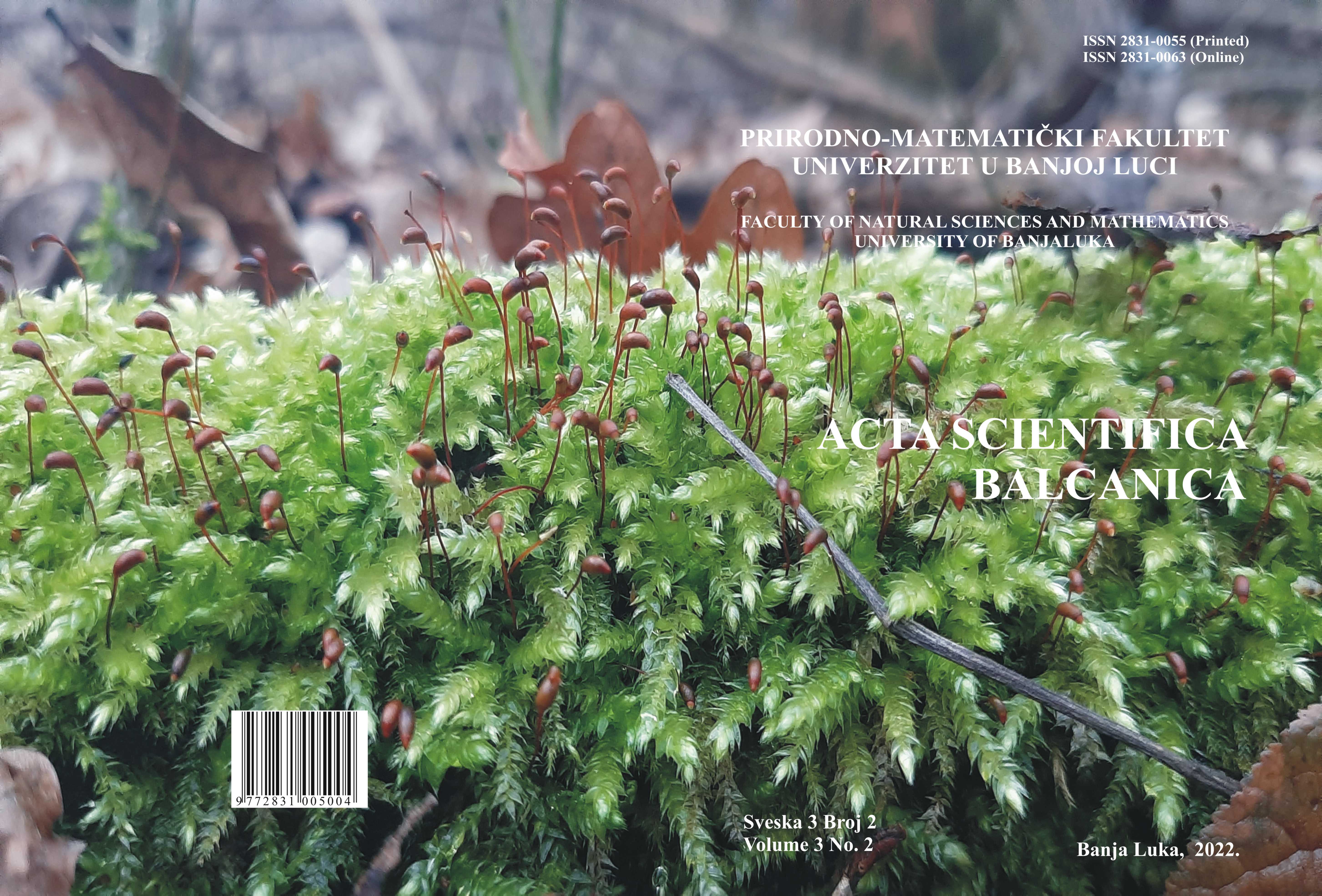TREATISE ON ASSESSMENT OF RISK ON AQUATIC ECOSYSTEM OF THE RIVER JADAR OWING TO EXPLOITATION OF BORON AND LITHIUM IN THE PROJECT „JADAR“
DOI:
https://doi.org/10.7251/ASB220302023SKeywords:
Jadar region, wastewaters, water pollution, hazard, lithium, boronAbstract
Risk assessment of the aquatic ecosystem of the River Jadar is based on the composition and amount of wastewater that is to be processed and released into the stream. This study aimed to assess the effects of untreated wastewater on aquatic ecosystem components, presumably fishes, by simulating the accident. Methodology relied exclusively on the published documents that investors, “Rio Tinto'' and “Rio Sava Exploration” d.o.o., issued about the boron and lithium mine in the Jadar region of Serbia as the only source of the publicly available data about concentration of mineral contents in underground water. Results revealed that concentrations of boron in a range of 3.43-12058.83 mg l-1 and those of lithium in a range of 0.70-2452.50 mg l-1 in a stream water of the River Jadar would pose a great risk to aquatic ecosystem in any lapse in proper processing of wastewater at either average low-, medium-, or high-water levels. Such high contents would inevitably cause toxic, genotoxic and other pathological effects on aquatic organisms. Records published on the relevant in vitro models reveal that if the concentration of boron and lithium in the stream water would exceed safe concentrations, the ecosystem would be seriously harmed, especially for the fish that are most sensitive to metal pollution. Due to a lack of actual referent in-field data, it is difficult to predict either the extent of harmful effects on downstream sections, or the period the ecosystem would need to recover from high levels of pollution.
References
Anonymous (2010). Pravilnik o proglašenju i zaštiti strogo zaštićenih i zaštićenih divljih vrsta biljaka, životinja i gljiva [Act on Announcement and Protecting Strictly Protected and Protected Wild Species of Plants, Animals and Fungi]. Official Gazette of Republic of Serbia 5/2010; 47/2011; 32/2016 and 98/2016.
Anonymous (2021a). Zahtev za određivanje obima i sadržaja studije o proceni uticaja na životnu sredinu [Request for Issuing Extent and Content of Environmental Impact Assessment Study]. Beograd: Rio Sava Exploration.
Anonymous (2021b). Odgovori na pitanja o projektu Jadar. Informaciona brošura [Answers on questions about the Project Jadar. Information brochure]. Beograd: Rio Tinto Group.
ANZG (2021). Toxicant default guideline values for aquatic ecosystem protection: Boron in freshwater. Australian and New Zealand Guidelines for Fresh and Marine Water Quality. CC BY 4.0. Canberra and Oukland: Australian and New Zealand Governments and Australian state and territory governments.
Eisler, R. (1990). Boron Hazards to Fish, Wildlife, and Invertebrates: A Synoptic Review. Biological Reports 85(1.20). Contaminant Hazard Reviews, Report 20. Washington: US Fish and Wildlife Service.
Gülsoy, N., Yavaş, C. & Mutlu, Ö. (2015). Genotoxic effects of boric acid and borax in zebrafish, Danio rerio using alkaline comet assay. EXCLI Journal, 14, 890-899. doi:10.17179/excli2015-404.
Ivković, M., Plavšić, J., Vladiković, D. & Jerinić, J. (2012). Primena modela HBV za hidrološku prognozu na slivu reke Jadar [Application of model HBV for hydrological predicting at the River Jadar drainage area]. Vodoprivreda, 44, 257-263.
JCWI (2019). Jadar Mine, Jadar Project, Wastewater Discharge Study. Final Report.
Josimović, B. & Nenković-Riznić, M. (2019). Prostorni plan područja posebne namene za realizaciju projekta eksploatacije i prerade minerala jadarita „Jadar“. Izveštaj o strateškoj proceni uticaja na životnu sredinu [Spatial Plan of Special Purpose Area for Realisation of Project “Jadar” for Exploitation and Processing of Mineral Jadarit. Report on Strategic Environmental Impact Assessment Study]. Beograd: Institut za arhitekturu i urbanizam Srbije & Ministarstvo građevinsrstva, saobraćaja i infrastrukture Republike Srbije.
Marić, S., Nikolić, V., Hegediš, A. & Simonović, P. (2003). Srednjoročni program unapređenja ribarstva na ribarskom području „Drina“ za period 2003. - 2007. godine [Mid-term Fishery Management Plan for River Drina Fishery in 2003. - 2007. time period]. Beograd: Univerzitet u Beogradu-Biološki fakultet.
Rio Tinto (2021). Project Jadar. Retrieved from: https://www.riotinto.com/operations/projects/jadar
Simonović, P., Povž, M., Piria, M., Treer, T., Adrović, A., Škrijelj, R., Nikolić, V. & Simić, V. (2015). Ichthyofauna of the River Sava system. Pp. 361-400. In: Milačić, R., Ščančar,
J. & M. Paunović (Eds.). The Sava River. The Handbook of Environmental Chemistry, 31. Springer-Verlag, Berlin-Heidelberg. doi: 10.1007/978-3-662-44034-6_14
Soucek, D. J., Dickinson, E. and Koch, B. T. (2011). Acute and chronic toxicity of boron to a variety of freshwater organisms. Environmental Toxicology and Chemistry, 30, 1906– 1914. doi: 10.1002/etc.578
Tkatcheva, V, Poirier, D., Chong-Kit, R., Furdui, V., Burr, C., Leger, R., Parmar, J., Switzer, T., Maedler, S., Reiner, E., Sherry, J. & Simmons D. (2015). Lithium an emerging contaminant: Bioavailability, effects on protein expression, and homeostasis disruption in short-term exposure of rainbow trout. Journal of Aquatic Toxicology, 161, 85-93. doi: 10.1016/j.aquatox.2015.01.030
Topal, A., Oruç, E., Altun, S., Buğrahan Ceyhun, S. & Atamanalp, M. (2016). The effects of acute boric acid treatment on gill, kidney and muscle tissues in juvenile rainbow trout. Journal of Applied Animal Research, 44(1), 297-302. doi: 10.1080/09712119.2015.1031784


